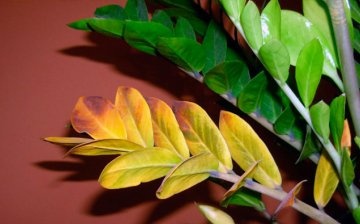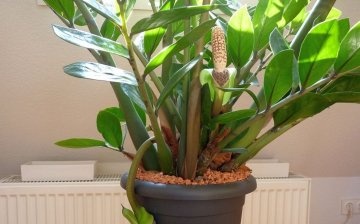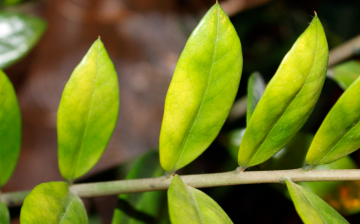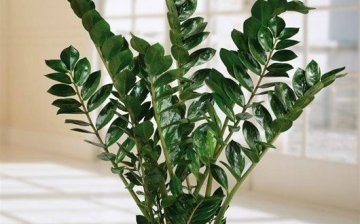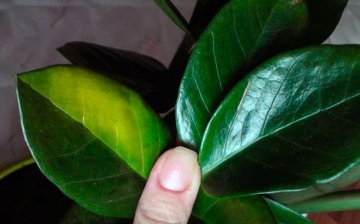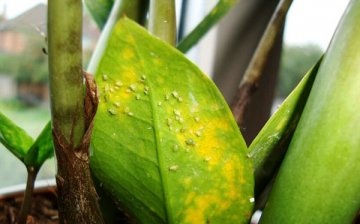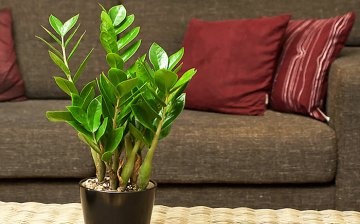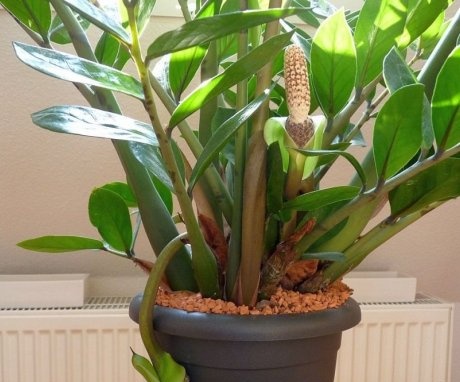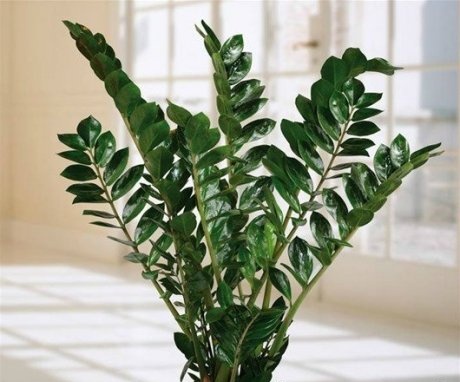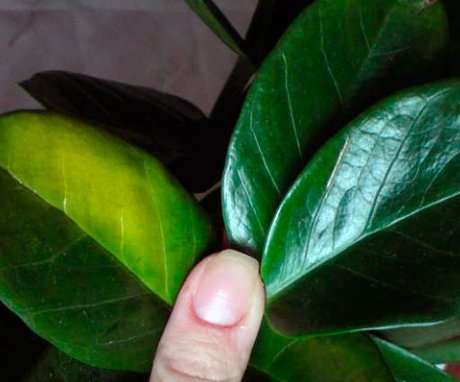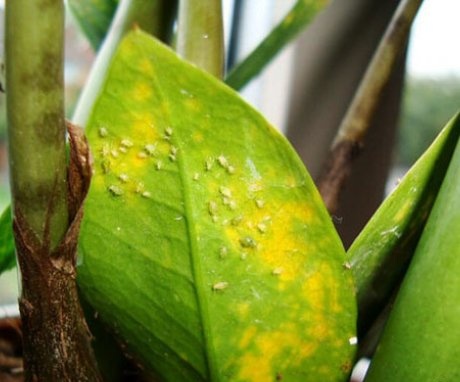The leaves of the dollar tree turn yellow: why and what to do?
A plant popularly called dollar tree in the scientific literature it is called Zamioculcas zamielistny. The shrub appears to be a foreign visitor from far east Africa, straight from Kenya.
It is revealed by a perennial bush, but in order for the plant to please with its fresh appearance and elastic leaves, it is recommended to monitor the implementation of correct watering. In addition, the general condition of the exotic should be constantly monitored, otherwise there is a likelihood of acquiring a flower of a yellowish tint of leaf plates.
Content:
- Features of the structure of the dollar tree
- Leaves turn yellow due to improper care
- What to do, how to properly care for the plant?
- Leaves turn yellow - the reason: disease
- How to cure a plant?
- Leaves turn yellow - the reason: pests
- How to get rid of pests from a plant?
Features of the structure of the dollar tree
The dollar tree in nature is represented by a herbaceous plant that does not grow more than 40-60 cm. When all the rules for the care and maintenance of the optimum temperature are followed, the plant tends to stretch up to 1 meter. The bush has a powerful root system and a fleshy stem. The root is represented by a tuberous shape with small but long filaments of roots diverging in different directions.
The plant is considered evergreen, but with a prolonged absence of watering, its gorgeous foliage quickly loses its shade and falls off.
The branched root system does not allow the plant to die. It is saturated with a large amount of nutrients that revive the lost beauty after adding the required amount of moisture to the soil. The leaf plates of the plant have a feathery appearance, stretching to a length of up to 60 cm. On each leaf there are 6-8 small leaf plates in pairs, not exceeding 15 cm in length. Each leaf has a smooth texture, glossy appearance and dark green tint.
At home, achieving flowering is quite problematic. The tree produces small inflorescences. The tree has beautiful flowers, their color range varies from yellowish to brown or red-burgundy. The ear is 5-7 cm in length, while it is slightly hidden under the foliage. The beginning of budding begins in mid-July and lasts until the last days of September. Before buying such an exotic, it is recommended to know quite important information - all areas of tropical exotic are poisonous.
Leaves turn yellow due to improper care
The appearance of a yellow tint in the foliage on the plant is a common sign of improper tree care. In order to identify the cause, it is necessary to examine the shrub. The following factors are identified that affect the external state of the flower:
- Waterlogging - the plant does not like waterlogged, marshy soils. Watering should be periodic, as needed.Before applying the nutrient moisture, it is recommended to check the condition of the soil substrate. For further irrigation, it is required that the earth dries out by 2-3 cm.
- Insufficient soil irrigation - it is not worth completely stopping the introduction of nutrient moisture into the soil of the plant. Although he does not like excessive moisture, it is required to nourish him periodically in moderation. If the root system does not receive nutrients for a long period of time, then the plant will quickly begin to change the shade of the foliage to yellow. At the same time, the leaf plates will begin to curl, dry and fall off.
- Lack of lighting - The African immigrant loves sunlight. Therefore, if you place it in a darkened place, then it will certainly change its color.
- Direct rays of the luminary - excessive intake of sunlight negatively affects the condition of the shrub. In the midday heat, without removing the tree from the southern windowsill, you can provoke the formation of not only yellowness on the leaf plates, but also the formation of burn spots.
- Excess input mineral and organic fertilizers - it is necessary to carry out feeding for the dollar plant. But you should strictly control the dosage and method of introducing nutrients.
- Insufficient temperature conditions, the presence of drafts - the temperature in the room where the zamioculcas is located should not be lower than +18 C. In addition, during strong drops in temperatures outside the window, it is recommended to lay a layer of foam plastic under the pallet. So the plant will be protected from cool drafts coming from the cracks in the window and cooling the soil.
- Increased temperature and low humidity (dry) - yellowing of the leaves is often observed in winter. In this case, the plant is placed close to heating devices, which, drying up oxygen, begin to provoke rapid evaporation of moisture from the surface of the leaf plates of the dollar tree.
- Transfer - for any shrub, moving from a familiar place to a new flowerpot is a stressful situation. Therefore, the shrub in most cases reacts with the manifestation of slight yellowing at the tips of the leaves. With rapid rooting and reproduction of optimal conditions around the bush, it provokes the return of the previous color color.
- Damage to the root system during loosening or transplanting provokes yellowing of the plant or its complete death. Therefore, any manipulations with exotic shrubs should be performed with increased caution.
Thus, all recommendations for caring for the plant should be carefully followed so as not to subsequently identify the reasons that led to the loss of a flowering, rich green shrub.
What to do, how to properly care for the plant?
To eliminate the reasons for the improper care of the plant, you should more carefully familiarize yourself with the requirements and rules for growing an exotic pet.
There are the following recommendations:
- Choosing a place - it is recommended to put a flowerpot with a flower on the south-east side or south-west. It should be monitored whether the sun's rays fall on the plant in the midday heat. If there is no other possibility and the plant is located on the south side, then during the period of the greatest increase in the volume of sunlight, zamioculcas need to be shaded with a curtain.
- The introduction of nutrient moisture - watering should be carried out as needed, at the moment when the earthy clod has dried out to a depth of 2-3 cm. With strong waterlogging, the root system of the dollar tree begins to rot. The plant can only be saved by preventing problems and reducing the volume and frequency of irrigation.
- If you identify the acquisition of yellowness on the foliage, as well as a drooping appearance, it is recommended to immediately transplant the shrub to a new place of residence.At the same time, it is recommended to carefully consider the root system during transplantation. If visible rot is detected, the damaged areas should be cut off and treated with wood ash or activated carbon.
- Fertilization - should be carried out strictly according to the instructions and the dosage for feeding should be measured. Excessive volume stimulates the shedding of leaf plates and contributes to the burning of exotic rhizomes.
- Transplanting - should be carried out by the transshipment method, so as not to provoke a long acclimatization of the plant in a new place. At the same time, during transplantation, damage to the rhizomes can be provoked, which will negatively affect the appearance of the plant.
Thus, the nutrient moisture should be applied correctly, adjusting the required volumes to properly nourish the dollar tree. It is imperative to carry out top dressing, but in a strictly allotted time and in small dosages.
Leaves turn yellow - the reason: disease
In most cases, zamioculcas is not affected by the disease. The only possible problems are rotting of the root system or stem. If a lesion of the rhizomes with rot is detected, the cause should be sought in improper watering or ill-considered planting of a plant in a new place of residence. In the case when the nutrient moisture is introduced incorrectly, excessive waterlogging occurs.
As a result of the ongoing process, not only the roots begin to rot, but the trunk also becomes lethargic, lifeless, the foliage brightens and acquires a yellowish tint.
Also, in case of improper planting, when hollow gaps remain near the root system. The latter accumulate water. All these reasons provoke the development of pathogenic bacteria, most often characterized by fungal diseases.
How to cure a plant?
In order to prevent fungal diseases on an exotic pet, it is recommended to follow certain rules:
- When replanting, carefully check for hollow holes in the ground. So that they do not form, you should slightly shake the plant when planting so that the earth settles and fills all the cavities formed.
- After watering, when excess liquid seeps into the pan, it is recommended to drain it. If you leave water, then the soil will continue to be saturated and, as a result, will provoke the development of pathogenic bacteria.
- To get rid of acquired rot, the areas with the greatest formation of dying tissue should be cut off from the decaying stem. The procedure should be carried out until completely healthy tissue. After that, it is required to treat the affected areas with the chemical insecticide Maxim. In addition, you can use disinfection in the form of a weak solution of potassium permanganate.
- When a tuber is rotting, it is recommended to transplant from infected soil to fresh, nutrient-rich soil. In this case, it is necessary to cut off all damaged parts from the root system and process it with crushed activated carbon.
- If the stem and root system cannot be healed, then it is required to cut off healthy areas that are not yet affected by the disease and root in fresh soil. Only in this case it will be possible to save a rare specimen.
Thus, in order to prevent the spread of the disease, the general condition of the shrub should be monitored. Immediately upon detection of yellowing of the foliage, take preventive and disinfection measures.
Leaves turn yellow - the reason: pests
In wildlife zamioculcas is a plant that is rarely affected by pathogenic parasites. Most often, harmful insects do not fly purposefully at the exotic, but move from one plant to another. In indoor growing conditions, in most cases, this is exactly what happens.
The dollar plant is distinguished by a dense structure of leaf plates, as well as their leathery appearance.Such a structure of the leaf causes a lot of effort so that the insect can pierce the leaf. Therefore, many parasitic individuals, settling on the surface of the leaves, cannot withstand the absence of food for a long time.
There are the following types of harmful insects that can harm the shrub and provoke yellowing of the leaf plates:
- Aphid - an insect of small size, appearing on the tops of a bush in a variety of colors. Parasites tend to colonize leaf blades and quickly increase their own population. They tend to settle on the underside of the leaf plate. In the place of localization of parasites, whitish traces and cobwebs remain.
- Spider mite is clearly visible on the foliage of the plant during visual inspection. It is represented by a small reddish spider, which in most cases are located in the internodes of the stems. When a small whitish cobweb appears on a plant, one can undoubtedly talk about the presence of a harmful parasite on the bush.
- Shield - if a waxy coating resembling a shield appears on the leaf plate, shield aphids can be found on the surface of the foliage. It forms a brown or yellowish shade of a flat structure of a flat type of plaque. The parasite multiplies rapidly and moves from one plant to another at a rapid pace.
- The brown worm is a parasite that harms the root system of the zamiokulkas. Identify a parasitic creature by pulling the plant out of the flowerpot and shaking off the soil from the roots. If there are cotton balls on the root processes, one can say for sure about the damage to the plant by the worm.
All pests feed on plant sap, therefore, when any of the parasites appears, the color of the deciduous cover of the exotic acquires a yellowish tint.
How to get rid of pests from a plant?
To eliminate intruders from a green pet, it is recommended to constantly monitor the state of the dollar tree. Upon initial detection, when the number of pests does not exceed the permissible norms, they can be eliminated manually without resorting to chemical insecticides.
There are the following ways to eliminate harmful insects from a green pet that feed on plant sap and give the flower a yellowish tint:
- Wash off with soapy water - a small amount can be neutralized with a solution based on laundry soap and wood ash. The combination of components makes it easy to eliminate deciduous shoots and prevent the emergence of new types of pests.
- Use chemical insecticides - if signs of damage to the flower were noticed at the last stage, then it will be possible to save the appearance of the plant only with the help of exposure to chemicals against parasitic individuals. The main thing is to dilute the concentration according to the instructions. Insufficient essence will not allow influencing the parasites, finally eliminating them.
- To eliminate the root worm, it is recommended to remove the plant from the earthy coma, shake off all the soil and rinse the tuber in hot liquid. It is recommended to additionally use a solution of Potassium Permanganate to disinfect the plant. After eliminating the worm, you should purchase a new flower, additionally disinfect it, and plant the plant in a fresh soil mixture, also calcined in the oven.
The bush should be carefully monitored so that no new inhabitants appear on the foliage of the bush. In most cases, all uninvited guests move into the flower if the care of an exotic tree is not carried out correctly.
Thus, the yellowing of the leafy plates of the zamiokulkas occurs due to improper care. In addition, the reason for the change in the external color of the foliage may indicate the defeat of an exotic pet by pathogenic bacteria or pests. It is possible to eliminate development factors both with the use of folk methods and through chemical insecticides.
More information can be found in the video:



